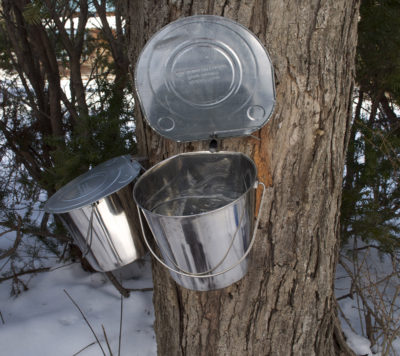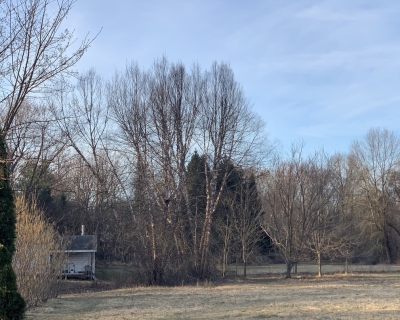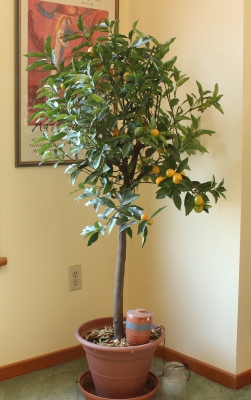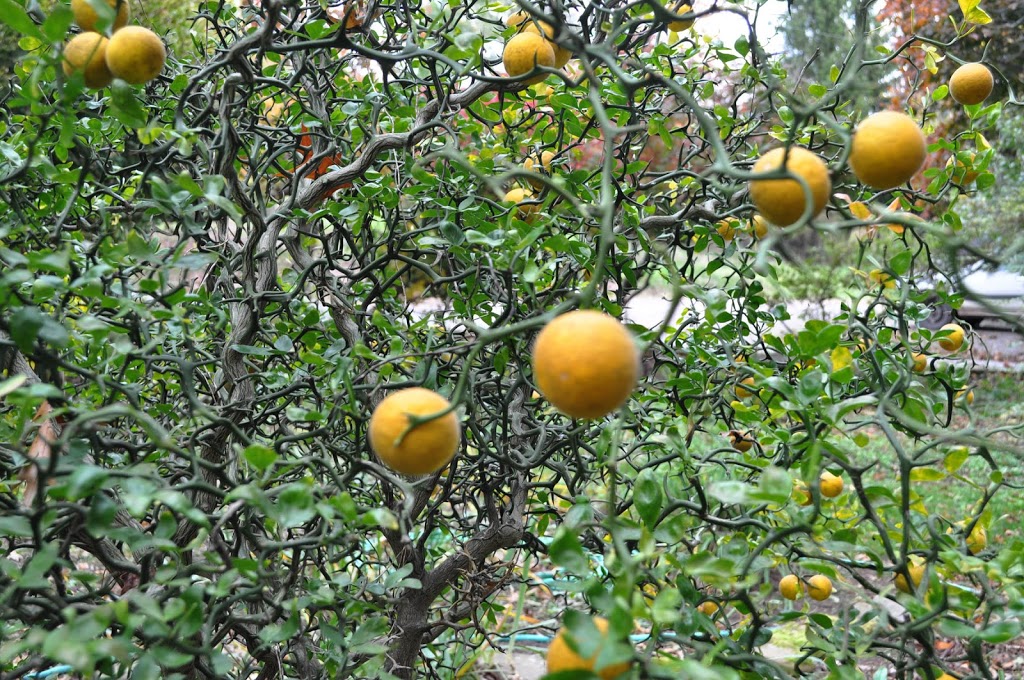OUTDOOR MAPLES AND INDOOR KUMQUATS
Sap Season
Get your taps in. It’s syrup weather. Maple syrup. At least here in New York’s Hudson Valley, the sunny days in the 40s with nights in the 20s that are predicted should get the sap flowing.
I say “should” because I haven’t yet checked sap buckets that I hung out on the trees a few weeks ago when winter temperatures suddenly turned warm; it was sap weather back then. That day was hopeful: I drilled holes an inch and a half deep, lightly hammered in the spiles, hung buckets, and attached covers over the buckets. Frigid days and nights that descended soon after that kept sap flow in abeyance.
My “sugar bush” amounts to only three sugar maple trees. I used to have four, but a large tree that was a truly magnificent representative of its species began an irreversible path to its death.
“Maple decline” is a disease complex brought on by some combination of drought, soil compaction, road salt, root damage, and air pollution. Upper branches are usually the first to go, and once decline begins, secondary fungi and insects speed the process along.
I’m not sure about my tree, though, because its lower branches were the first to go. Also, the tree grows along the back edge of my property, where it’s been shielded from those usual causes for decline.
One more contributor to decline is overtapping. I plead not guilty. My fading tree was larger than the 8 or10 inch minimum diameter for tapping, and I only tapped it once, when the tree, it turned out, was already going downhill. The lack of sap flow was what prompted me to see all this. And then I noticed many rows of sapsucker holes in the bark.
Long story short: The tree became firewood.
My three other, healthy maples might yield me only a quart of finished syrup. The reasons? One quart is enough for me, so I’m tapping only one of them. Also, they’re relatively young. I planted those three trees about 25 years ago, and they’re now only about 8 inches in diameter.I highly recommend planting trees, for their beauty, for what food they might offer, and for the mere satisfaction of watching the plants grow. Especially if they are small when planted. Small trees also establish quickly to require less aftercare, often soon outgrowing their initially larger compatriots. Those three maple trees? From one perspective, it seems like a long time ago that I dug holes and set the saplings in the ground; from another perspective, it seems like I planted them, walked away, then turned right around to find that these young ‘uns have grown into bona fide trees!
Birch Sap
I may end up with more sap than planned, but not maple sap. Along with the three sugar maples I planted way back when, I also planted three river birches (Betula nigra). They grow, appropriate to their name, in a wet area just out of a swale through which water runs in spring, each a clump of a half dozen or so sturdy trunks reaching skyward to about 35 feet.
Maple might be the heaviest sap producing tree, but it’s not the only kid on the block. Many people tap their black walnut trees. Call me provincial, but black walnut syrup, much as I love the nuts themselves, has no appeal me even though I’ve never tasted it.
Birch syrup though . . . mmm. Never tasted that one either, but it sounds good. Three birch taps should offer an ample amount for tasting.
What a Funny Name
I don’t need to see the small, pebbly-skinned, orange orbs on grocers’ shelves to know that it’s kumquat season. My own Meiwa kumquat is looking very pretty, with a good crop of fruit staring out from their backdrop of glossy, forest-green leaves. I’ve trained the plant as a “standard,” that is, as a miniature tree with a crown of branches perched atop a four foot trunk.
The present crop is my best ever, and traces its success back to last spring. In previous years, I was too timid with pruning. And pruning is necessary, every year. Pruning keeps the plant from growing disproportionately large for its pot -– or my house — and coaxes growth of new, fruiting wood.The roots also get pruned each year to make space for new potting soil for root growth and nutrients. I laid down the plant and pot to easily slide out the root ball. After slicing an inch or two of roots and potting soil from all around the outside of the root ball, back into the pot the plant went, with new potting soil packed in the space between the shaven root ball and the inside edge of the pot. The seemingly brutal treatment took place last year just as the garden awoke in yellow blossoms from daffodils.
As soon as weather warmed, new sprouts began to grow. By midsummer, the plant was fragrant with blossoms. By late summer, little, green fruits were forming which, with careful watering, survived the environment change as the plant moved indoors in October. The plant stood at attention in a sunny window in the cool bedroom for weeks, and a couple of months ago, the fruits started turning orange. They are now ripe and delicious!







Trust me, black walnut syrup is *great*. I’ve got dozens of those, so a couple of years back, I did a test run and tapped a handful of the uglier ones and did my collecting in late February (Western NY) when the conditions are as you describe. It was just a trial for the future, so I only collected & processed enough to make a mere pint, but it was wonderful. It tasted as sweet as maple syrup but “different”. I wouldn’t call it nutty, but it did have a buttery undertone.
I intend to make an outdoor boiler (to save my gas bill and avoid steaming up the house) and I will ramp up a little just so there’s enough to supply my family for a year.
There are some specialty places that sell jars of walnut syrup—give it a try!
On the recommendation of you and others, I am tapping one black walnut tree this spring. I put the tap in yesterday.
I’ve been root pruning in the fall as prep to bring my house plants inside thinking it was a way of eliminating hitchhiking pests. It worked well but I’d like to try your timing. Would you suggest when’s not a good time? And do you spray for possible hidden hitchhikers before bringing your plants inside?
Thanks for sharing your expertise through your blog! I don’t grow food but still come across some gems from you.
Fall is also a good time for root pruning. I don’t worry about hitchhiking pests which anyway could also be present on parts of the root ball left after root pruning.
Hi Lee – I have a kumquat abt the same size & pot as yours. I know you cut the roots in the spring time, I’ve never done that, but when’s the best time to prune the leaves? I was worried that I didn’t time it right because the leaves on the new growth came out twice the size of the other leaves, which I did not like. I’ve never had fruits on mine.
In its winter home, in a cool room, it shed quite a lot of leaves. Still alive ‘tho. Do you thin as well as head back?
I prune kumquat in spring. Perhaps your pruning too severely; the vigorous growth that induces might result in larger leaves. I do thinning cuts first, then some heading cuts.
Hi, Lee – I’ve tapped our black walnuts in the past. It takes way too much propane and sap to make walnut syrup but the sap itself is a wonderful, icy clear liquid with just a hint of nutty sweetness. Tastes like drinking the essence of spring. I highly recommend doing it at least once.
I’m going to do it. I put a tap into a walnut today. I boil — or, rather, simmer sap on my woodstove, which is anyway hot the time of year so there’s no extra energy used or expense incurred. It’s necessary to keep a close look on the hot sap as it gets near the finish point; that’s when it starts to boil.
Yeah, it does take a lot of heat to cook down any of these tree sap syrups. Black walnut, just like sugar maple, requires about a 40:1 reduction. Doing it as Lee says is great, although in very large quantities or repeatedly that would put a lot of moisture inside the house and risk condensation inside the cold outer surfaces of exterior walls.
For those without a woodstove going anyhow, or for making a whole bunch, I think cooking it down outside in a chafing pan over a junk wood fire is the way to go. There are kits to convert a steel barrel (clean of anything toxic) into a wood stove which I have seen people use. Regardless of how you do it, when it gets close to being done, it’s probably better to do the final part on a gas or propane stove for better control.
Inside on my woodstove, the sap never boils, just gently steams away until the end. I keep topping up the sap with newly harvested sap, so that process goes on for a long time. No rush for me. Towards the end, though, it will boil, so I eye it closely then.
Is this the same root pruning that you do for your figs? I have two figs that are starting their 3rd year in the same pots. How do I know when and if to root prune them?
Yes, same with figs and any other potted plant. When? Check out the roots. Typically, once the plant is more than 2 or 3 times the height of its container, pruning is necessary.
Do you advise this kind of treatment for a meyer lemon in a pot? I mean root pruning and regular pruning.
Yes. But be careful to try not to cut off stems with flower buds of fruits.
Hi Lee,
thanks so much for all the great info you provide! I thought i read, either on your blog or in on of your books, about what to use to sterilise pruning tools, but i can’t seem to find it now. Unfortunately after last years extreme late frost damage and dry hot weather a few of my trees are looking diseased. While trimming I used up the last of my rubbing alcohol, which i bought for a fortune at a drugstore here in germany a few years back.
Kind Regards,
Selena
Here’s what I said in my book, THE PRUNING BOOK, That “clean” in “clean tools” means so in terms of dirt as well as microbes. It’s much harder to sterilize a tool that’s dirty or, because of pitting of metal, even old. So clean the tool and then either dip it or wipe it with alcohol, Listerine®, Lysol®, or Pine-Sol®. A solution of bleach is frequently recommended, and is effective except that it, as well as the also recommended trisodium phosphate, will damage the metal of pruning tools.
Thankyou, that was just what I was looking for! I knew I read it somewhere, funny, your pruning book (whick is fantastic!) was the first place I looked. I have now swapped to Listerine®, and my garden shed smells a bit minty (-:
Very cheap vodka is probably less expensive than pharmaceutical rubbing alcohol. There’s more water in the vodka (it’s usually about 40% alcohol) than with the rubbing alcohol (usually 70% alcohol, at least in the USA), so factor that in. I assume it is still strong enough to work, though.
Another option is to find an industrial source for isopropanol (also called isopropyl alcohol), which is the actual alcohol in “rubbing alcohol”. It might be cheaper to buy a large quantity this way, rather than buying diluted with 30% water as “rubbing alcohol” in the drug store.
It takes only a very small amount of alcohol to wet a rag enough to wipe down the blades of pruning tools, even repeatedly. Of put the alcohol in a spray bottle, spray enough on just to wet the blades, then wipe it off.
Birch syrup is delicious. Here in southeast Alaska we don’t have maples but the native birch makes a fine syrup.
Thanks for the information. What kind of birch do you tap. Mine are river birches. I’m sure black birch, which smells sort of like wintergreen when cut, would make ann interesting syrop.
“I highly recommend planting trees, for their beauty, for what food they might offer, and for the mere satisfaction of watching the plants grow. Especially if they are small when planted.”
I agree! About five years ago, I learned that if I fenced off a section of my yard, that trees would just sprout out of the ground. It doesn’t matter how big the fence is, but we have settled on utility panels 8ft long by 4ish feet tall. We make a square out of four panels, and then wait a couple years to see what pops up.
We have been rewarded with Shagbark Hickories, Quaking Aspens, Paper Birches, Sugar Maples, and four White Oaks. Also, if I am really patient, understory plants start to pop up too. Mostly low bush blueberries, but also Mapleleaf Viburnums, Arrowood Viburnums, Nannyberries, Dogwoods, and Witch Hazels.
The reason for the fencing is to keep the deer from eating the saplings when they are small. I have read that if I can keep the fences up until the trees are 8 feet tall, that the trees can take a bit of browsing then, and we can take the fences down. In the interim, tho, it’s been great fun to see what will grow on our property, if we give it a chance.
Nice. Soon you’ll have your own forestette also. You mush have a big yard; the oak, maple, and hickory can grow quite large, and will before you know it.